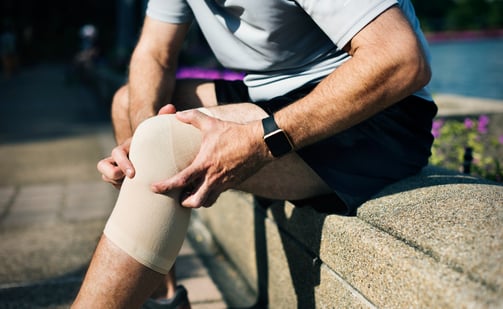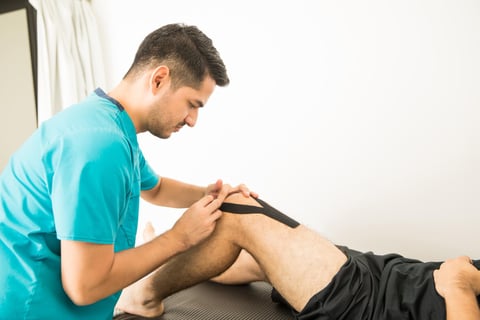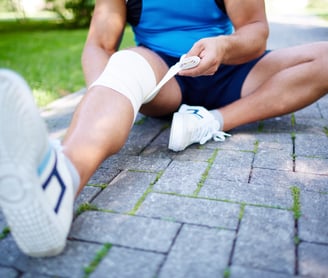How to Strap a Knee?
SPORTSFEATURED


Discover the intricacies of how to strap a knee with an all-inclusive guide. Learn techniques, materials & methodologies for knee strapping to promote healing.
Knee injuries can be a real hindrance, whether you're an athlete or just someone who enjoys a good walk. Learning how to strap a knee is an indispensable skill that can provide immediate relief and aid in long-term recovery. This article is a one-stop guide to everything you need to know about strapping a knee, including techniques, reasons, types of straps, prevention, and much more.
Table of Contents
How to Strap a Knee?
Introduction to Knee Strapping
What is Knee Strapping? Why is it Important?
Anatomy of the Knee
Understanding the Structure
Common Injuries
How to Identify a Knee Injury
Symptoms
Professional Help
Immediate Actions
Tools and Materials for Knee Strapping
Types of Straps, Tapes, Braces
Techniques for Knee Strapping
Step-by-Step Guide
Knee Strapping for Different Injuries
ACL Injuries
Meniscus Tears
Tendonitis
Professional vs. DIY Knee Strapping
Pros and Cons
When to Seek Professional Help
Alternatives and Supplements to Knee Strapping
Physical Therapy
Surgery
Alternative Therapies
Prevention Strategies
Warm-Up
Strengthening Exercises
Lifestyle Changes
Common Myths and Misconceptions about Knee Strapping
Myth: Tighter is Always Better
Myth: Knee Strapping Can Cure Injuries
Myth: One Method Fits All
Myth: Strapping Can Replace Warming Up
Care and Maintenance of Knee Straps and Braces
Cleaning
Inspection
Replacement
A Personal Experience with Knee Strapping
My Journey with Knee Strapping
Finding the Right Support
The Role of Professionals
Advanced Techniques for Professional Athletes
Specific Sports Requirements
Continuous Professional Support
Custom-made Braces
Conclusion
FAQs
What are the benefits of knee strapping?
How do I choose the right strap or tape for my knee?
Can knee strapping replace professional medical care?
How often should I replace or adjust the knee strap?
Is knee strapping suitable for all types of knee injuries?
What can I do to prevent knee injuries?
How to Strap a Knee?
Understanding how to strap a knee is vital for anyone engaged in activities that might put a strain on the knee joint. Our extensive guide offers a deep dive into this crucial topic.
Introduction to Knee Strapping
What is Knee Strapping? Why is it Important?
Knee strapping refers to the process of applying a strap or tape around the knee to provide support, alleviate pain, and facilitate healing. It's a common practice among athletes and physically active individuals. But why is it so crucial? Knee strapping helps in:
Reducing Pain: By supporting the affected area, knee strapping can provide immediate relief from discomfort.
Enhancing Recovery: It aids the healing process by keeping the injured parts in alignment.
Preventing Further Injuries: By limiting movement in certain directions, it helps in avoiding additional strain on an already injured knee.
Anatomy of the Knee
Understanding the Structure
The knee is a complex joint that consists of bones, ligaments, tendons, and cartilage. Understanding its anatomy is paramount when learning how to strap a knee. Here's a brief overview:
Bones: Femur, Tibia, Fibula, and Patella.
Ligaments: Including ACL (anterior cruciate ligament), PCL (posterior cruciate ligament).
Tendons and Cartilage: Various connecting tissues.
Common Injuries
Different parts of the knee can be prone to various injuries such as:
ACL Tears: Often occur during sports involving sudden stops and changes in direction.
Meniscus Tears: Can happen during twisting movements.
Tendonitis: Inflammation of the tendons.
Knowing these injuries helps in understanding the proper way to strap a knee.
How to Identify a Knee Injury
Symptoms
Some common symptoms of a knee injury include:
Pain or swelling
Limited movement
Popping or crunching noises
Professional Help
If you suspect a serious knee injury, it's always wise to seek professional help. Medical professionals can diagnose and provide appropriate care.
Immediate Actions
While waiting for professional help, you can:
Rest the knee: Avoid putting weight on it.
Apply ice: This can reduce swelling.
Compress: Use a bandage to provide support.
Tools and Materials for Knee Strapping
Types of Straps, Tapes, Braces
Various tools are available for knee strapping. They include:
Knee Straps: Often used for patellar tendonitis.
Kinesiology Tape: For overall support.
Braces: Ranging from simple sleeves to hinged braces for severe injuries.
Techniques for Knee Strapping
Step-by-Step Guide
Strapping a knee might seem complicated, but with some guidance, you can master it. Here's a general step-by-step guide:
Prepare the Skin: Clean and dry the area around the knee.
Apply Underwrap: This provides a protective layer.
Position the Knee: Keep it slightly bent.
Apply the Strap or Tape: Follow the specific technique required for your injury.
Check Comfort: Make sure it's not too tight or loose.
Secure with Tape: If necessary, secure it further with medical tape.
Common Techniques
I-Strip Application: Used for general support.
X-Technique: Effective for ACL support.
Donut Strapping: For patellar support.
Tips and Tricks
Always follow the manufacturer's instructions if using a specific product.
Seek professional guidance if unsure about the technique.
Knee Strapping for Different Injuries
ACL Injuries
Strapping techniques vary depending on the injury. For ACL injuries, using hinged braces or specific taping techniques can be highly effective.
Meniscus Tears
Supporting the joint while allowing some movement is essential for meniscus injuries. The right strapping can make a significant difference.
Tendonitis
Simple straps or tapes are often sufficient for tendonitis, providing targeted support where needed.
Professional vs. DIY Knee Strapping
Pros and Cons
Professional Strapping: Offers precise application and support but can be costly.
DIY Strapping: More accessible and budget-friendly, but requires knowledge and skill.
When to Seek Professional Help
If you're dealing with a severe injury or unsure about how to strap a knee properly, professional assistance is the best route. Therapists can provide tailored support.
Alternatives and Supplements to Knee Strapping
Physical Therapy
Physical therapy offers structured rehabilitation, strengthening muscles around the knee, and improving overall function.
Surgery
In severe cases, surgery may be the only option. It requires post-operative care, including possible knee strapping.
Alternative Therapies
Some may find relief through acupuncture, chiropractic care, or massage therapy, alongside knee strapping.
Prevention Strategies
Warm-Up
A proper warm-up prepares the body for exercise, reducing the risk of knee injuries.
Strengthening Exercises
Building strength in the muscles supporting the knee can prevent many common injuries.
Lifestyle Changes
Maintaining a healthy weight and being mindful of activities can minimize unnecessary strain on the knees.
Common Myths and Misconceptions about Knee Strapping
Understanding how to strap a knee properly requires not only knowing the correct techniques but also debunking common myths and misconceptions.
Myth: Tighter is Always Better
Fact: Strapping the knee too tightly can restrict blood flow and cause more harm. It should be snug but not uncomfortably tight.
Myth: Knee Strapping Can Cure Injuries
Fact: While strapping can support and alleviate pain, it's not a cure for underlying injuries. Proper medical assessment and treatment are essential.
Myth: One Method Fits All
Fact: Different knee injuries require different strapping techniques. Using the wrong method can lead to further complications.
Myth: Strapping Can Replace Warming Up
Fact: While strapping can provide support, it doesn't replace the need for a proper warm-up before engaging in physical activities.


Care and Maintenance of Knee Straps and Braces
Quality care and maintenance of knee straps and braces prolong their lifespan and ensure that they continue to provide optimal support.
Cleaning
Regular cleaning is essential. Follow the manufacturer's instructions, which may include:
Hand washing with mild soap
Air drying (avoiding direct heat)
Inspection
Regularly inspect for:
Wear and tear
Elasticity loss
Damaged fasteners or hinges
Replacement
Know when to replace straps and braces. Signs of wear or reduced support may indicate that it's time for a new one.
A Personal Experience with Knee Strapping
My Journey with Knee Strapping
As a former athlete who suffered a significant knee injury, my journey into learning how to strap a knee began out of necessity. Knee strapping became an integral part of my recovery and daily life.
Finding the Right Support
Finding the proper technique and type of strap was a process of trial and error, with professional guidance. The relief and support it provided were immediate and apparent.
The Role of Professionals
Physiotherapists played an essential role in teaching the right way to strap my knee, and their expertise made all the difference in my recovery.
Advanced Techniques for Professional Athletes
Professional athletes often require advanced strapping techniques to support high-performance demands.
Specific Sports Requirements
Different sports place unique demands on the knee, requiring specific strapping techniques. For example:
Runners may need focused patellar support
Footballers might require complex strapping for ligament stability
Continuous Professional Support
Professional athletes usually have ongoing support from physiotherapists or athletic trainers. They ensure the strapping is done correctly and efficiently, based on the athlete's specific needs.
Custom-made Braces
Some professional athletes might benefit from custom-made braces, designed specifically for their anatomy and the demands of their sport.
Conclusion


The process of learning how to strap a knee can be an empowering journey for anyone dealing with knee pain or injuries. From debunking common myths to understanding the personal experiences and the specialised needs of professional athletes, this comprehensive guide provides insights into every facet of knee strapping.
Whether you're an athlete or someone who wants to stay active and healthy, knowing how to strap a knee can make a significant difference in your life. Embrace the knowledge, seek professional guidance when needed, and take control of your knee health today.
FAQs
What are the benefits of knee strapping?
Knee strapping offers support, pain relief, and aids in recovery from injuries.
How do I choose the right strap or tape for my knee?
The choice depends on the injury and personal preference. Consulting a professional can ensure the best selection.
Can knee strapping replace professional medical care?
No, knee strapping is a supportive measure and should not replace professional diagnosis and treatment.
How often should I replace or adjust the knee strap?
It depends on the type of strap and the level of activity. Regular inspection for wear and comfort is essential.
Is knee strapping suitable for all types of knee injuries?
Most injuries can benefit from knee strapping, but the method may vary. Professional guidance is advised for severe injuries.
What can I do to prevent knee injuries?
Prevention includes proper warm-up, strength training, lifestyle adjustments, and wearing appropriate footwear.